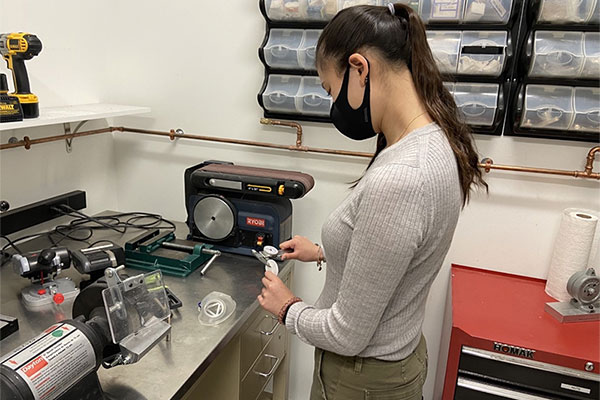Co-op Leads to Two Publications, Three Patents

Caitlynn Tov, E’21, bioengineering, conducted research at Brigham and Women’s Hospital on the TEAL Bio face mask while on co-op, leading to her authoring/contributing to two papers and three patents. The mask is made of a clear silicone rubber material with removable filters and is equally as effective as the N95 mask.
While on co-op during the peak of the Coronavirus pandemic, Caitlynn Tov, E’21, assisted in the development of a new mask to prevent the spread of COVID-19. Tov, who is majoring in bioengineering with a concentration in medical devices, worked in the laboratory of MIT Assistant Professor Giovanni Traverso at Brigham and Women’s Hospital. The lab primarily designs ingestible drug delivery implants.
Tov says, “I knew I wanted to get involved with implants for my second co-op because my first co-op was [working on] a consumer product. I wanted exposure to medical devices and I’ve always been interested in implants.”
Tov was specifically working on the TEAL Bio face mask, which was spotlighted in a WHDH TV 7 News segment. The mask is made of a clear silicone rubber material with removable filters and is equally as effective as the N95 mask. When the filters are removed the mask can be sterilized and new, clean filters are put in which allows the mask to be reused.
When the pandemic hit, the only people allowed to continue working in the lab were those involved in COVID-19 related projects and fortunately, Tov fell within this category of workers. She had been working on this project onsite for about two weeks before starting to work from home.
To continue contributing to the project, she took a few masks and sensors home with her to test out the filters.

Caitlynn Tov, E’21, bioengineering, worked on co-op at Brigham and Women’s Hospital on the TEAL Bio face mask that is made of a clear silicone rubber material with removable filters and is equally as effective as the N95 mask.
“I [would sit] in my bedroom, put on the mask, and breathe into it with the sensor in [the mask] which measures CO2, humidity, and pressure. [The purpose of this] was to make sure that there wasn’t too much CO2 build up because that can cause a bunch of health issues and make you really lightheaded,” she explains. “Also, the humidity was [monitored] because if [the sensor] got too wet then the sensor would stop working. Lastly, monitoring pressure was important so that we could compare the pressure differences between exhalation and inhalation.” She also assisted with the design elements of the mask by editing digital computer-aided design files.
After a month and a half of working from home, Tov was able to return to the lab where she continued to assist in the design elements of the mask by analyzing face scans with the goal of optimizing the fit and comfortability of the mask. She was also involved in the clinical trials and was able to interact with the doctors and nurses at Massachusetts General Hospital who would benefit the most from this mask.
“It was cool to collaborate with doctors as an engineer. I like the bridge of working with doctors and translating what they say to make a product that fits the needs of both,” she says.
For all her contributions, Tov was listed as an author/contributor in two papers and three patents for the TEAL Bio face mask. She also appreciated that she was able to work on a project that was on its way to being sent out to patients in hospitals.
“It was scary to have to commute into work [and] be around people [on public transportation] which made me wary, but it was nice to know that I was considered a healthcare worker contributing to helping the nurses and doctors in the field,” Tov says. “It was rewarding to give them a sense of hope and also see everyone come together.”